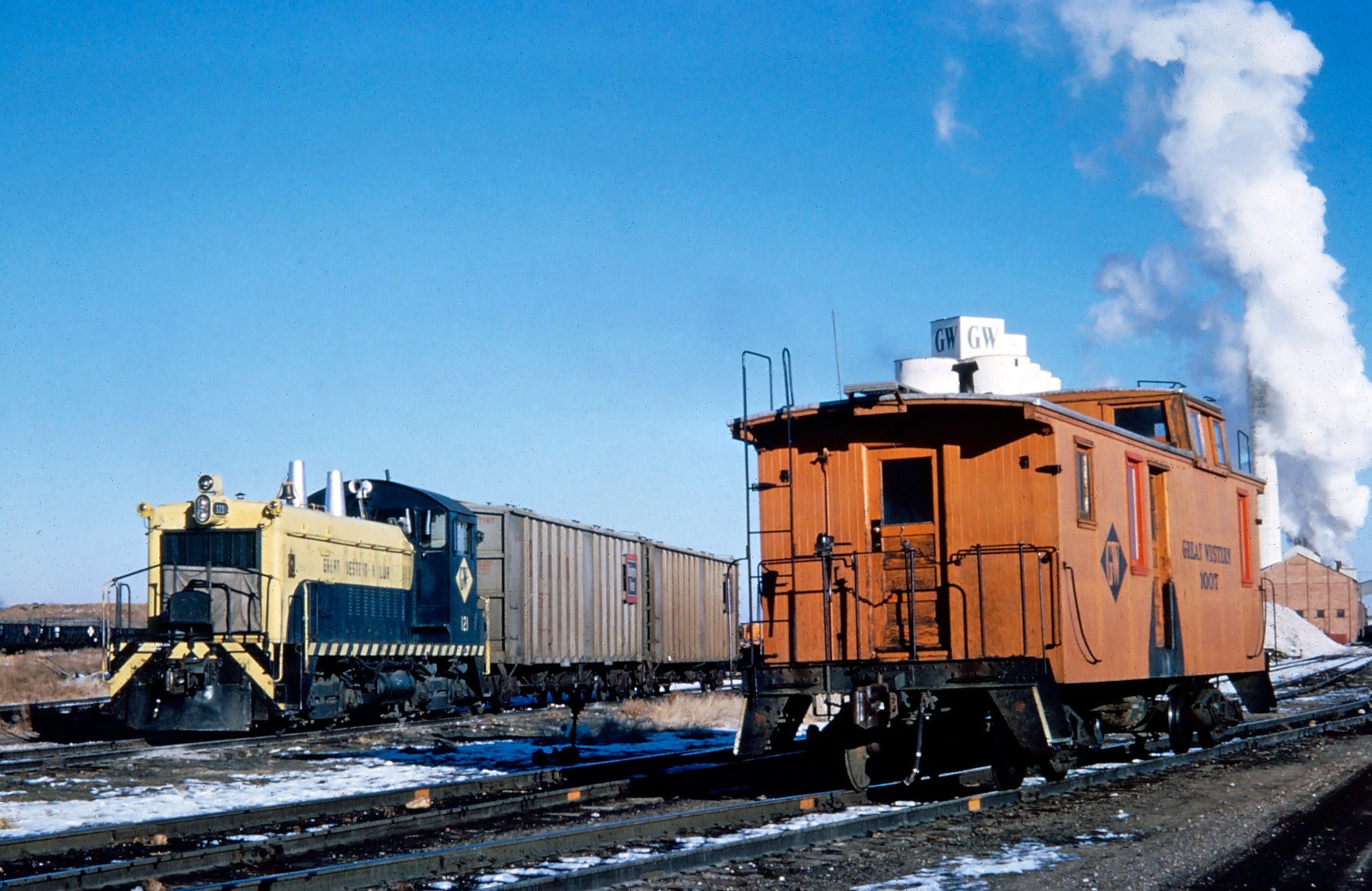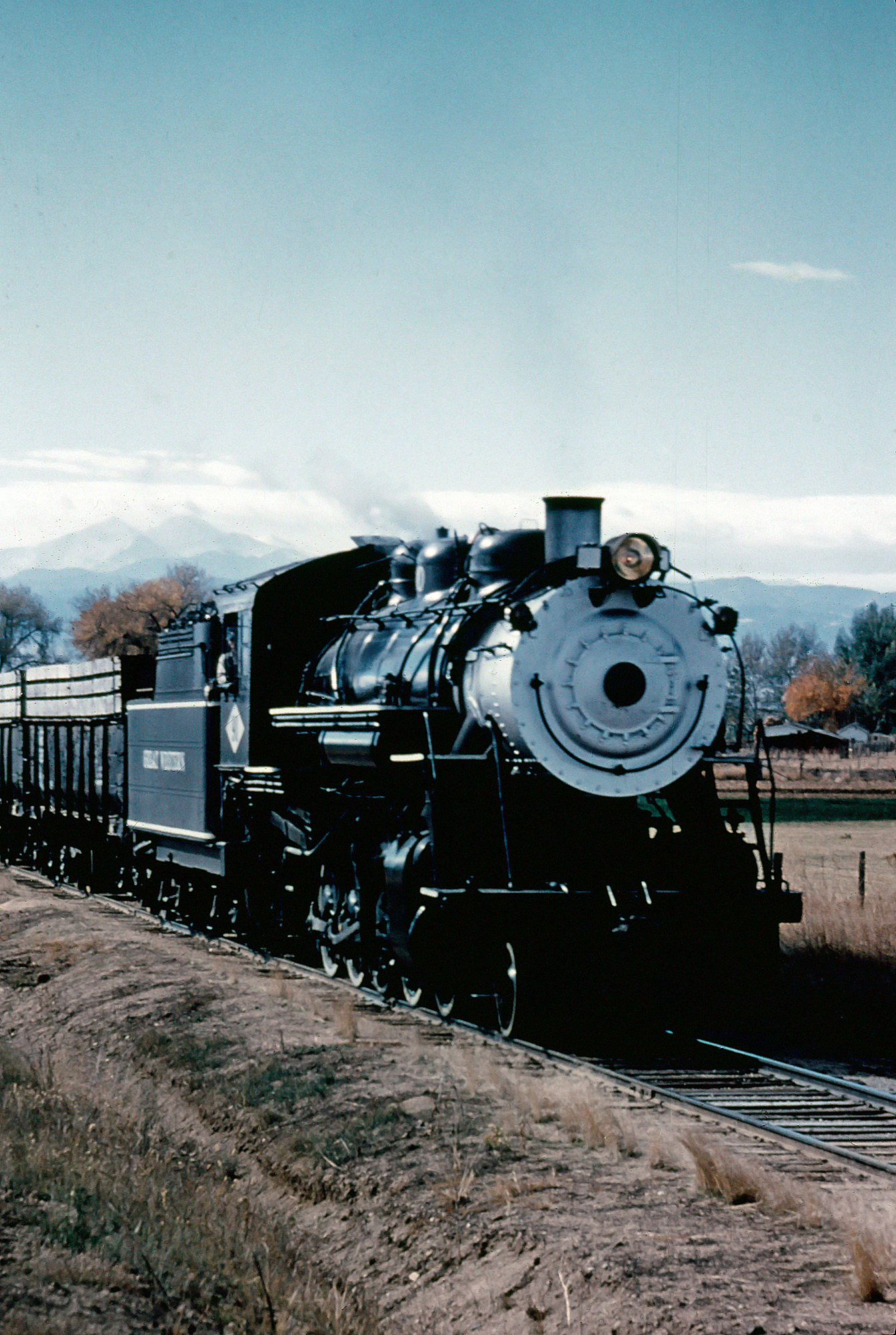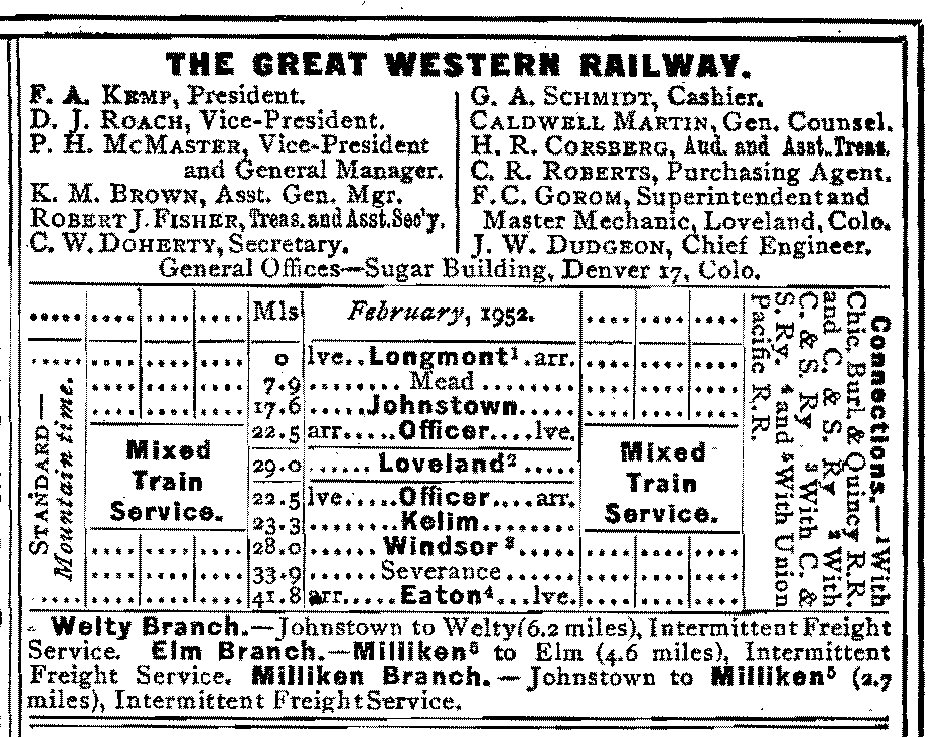Great Western Railway of Colorado: A Sweet Operation
Published: June 29, 2024
By: Adam Burns
The Great Western Railway of Colorado (GWR) has a storied history that spans over a century, marked by its significant contributions to the agricultural and industrial sectors of northern Colorado.
Established in the late 19th century, this shortline railroad has evolved through various ownerships and operational shifts while maintaining its commitment to providing efficient rail services.
Within the train enthusiast community the railroad is perhaps best known for its former Decapod, 2-10-0 #90, that still regularly hosts excursions on the Strasburg Rail Road in Strasburg, Pennsylvania. The engine is the only of its type still in operation.
 The Great Western Railway (of Colorado) SW9 #121 and caboose #1007 at the Great Western Sugar Company's plant in Loveland, Colorado, circa 1965. American-Rails.com collection.
The Great Western Railway (of Colorado) SW9 #121 and caboose #1007 at the Great Western Sugar Company's plant in Loveland, Colorado, circa 1965. American-Rails.com collection.Early Beginnings
The Great Western Railway was incorporated in 1901 by the Great Western Sugar Company. The primary motivation behind its creation was to support the burgeoning sugar beet industry in northern Colorado.
This region was emerging as a prolific producer of sugar beets, and efficient transportation was crucial for delivering the harvested beets to processing facilities.
The construction of the railway began in earnest, with the first trains running by 1902. Initially, the GWR's network spanned approximately 40 miles, connecting various sugar beet fields with the Great Western Sugar Company's processing plants located in Loveland, Longmont, Johnstown, and Fort Collins.
Technological Advancements
As the railway grew, it embraced technological advancements to improve its operations. In the 1920s, the GWR began to transition from steam locomotives to diesel-powered engines. This shift resulted in increased efficiency, lower operational costs, and improved reliability.
The adoption of diesels was a significant milestone for the Great Western Railway, allowing it to maintain its competitive edge in the transportation industry. The diesel engines provided greater power and flexibility, enabling the railway to handle larger volumes of freight.
Changes in Ownership
Throughout its history, the Great Western Railway underwent several changes in ownership. In June, 1986 the railroad was sold by Great Western Sugar to the Castle Corporation (BROE Corporation). It was later sold to Denver-based short line conglomerate OmniTRAX of Denver.
OmniTRAX's expertise and focus on shortline railroads allowed the GWRC to thrive in an evolving transportation landscape.
Current Operations
Today, the Great Western Railway of Colorado operates as a modern shortline railroad, providing essential freight services to northern Colorado and beyond. Its current operations reflect a blend of historical legacy and contemporary efficiency.
Official Guide Listing (1952)
Route and Network
The GWR's network spans approximately 80 miles, primarily serving the agricultural and industrial regions of Weld and Larimer counties. The railway's mainline runs from Loveland to Johnstown, with additional branches extending to Fort Collins, Windsor, Eaton, and Longmont.
These routes connect various industrial facilities, warehouses, and agricultural sites, facilitating the movement of diverse commodities. The GWRC's strategic location allows it to serve as a vital link between local industries and the broader national rail network.
Key Customers and Commodities
The Great Western Railway of Colorado serves a diverse range of customers, including agricultural producers, food processors, manufacturers, and energy companies. Some of the key commodities transported by the GWRC include:
1. **Agricultural Products:** The railway continues to transport sugar beets, corn, wheat, barley, and other grains from the fertile fields of northern Colorado to processing plants and distribution centers.
2. **Food Products:** The GWRC plays a crucial role in the food supply chain, transporting processed foods, beverages, and animal feed to various markets.
3. **Industrial Materials:** The railway moves essential industrial materials such as chemicals, plastics, and construction materials, supporting the region's manufacturing and construction sectors.
4. **Energy Resources:** The GWRC also transports energy resources, including crude oil, natural gas liquids, and renewable energy components, contributing to the region's energy industry.
Locomotive Fleet and Technology
The Great Western Railway operates a modern fleet of diesel locomotives, ensuring efficient and reliable freight services. The railway's locomotives are equipped with advanced technology, including GPS tracking and remote monitoring systems, which enhance operational efficiency and safety.
In addition to its locomotive fleet, the GWR has invested in modern railcars and infrastructure. These investments enable the railway to handle a wide variety of freight, from bulk commodities to specialized cargo, meeting the diverse needs of its customers.
Interchange Connections
The GWR maintains interchanges with several major railroads, including the Union Pacific (UP) and the BNSF Railway (BNSF). These interconnections allow the GWRC to provide seamless transportation services, facilitating the movement of goods to national and international markets.
The interchanges also enhance the railway's flexibility and responsiveness, enabling it to handle both short-haul and long-haul freight efficiently. This connectivity is a key advantage for the GWR, ensuring that its customers have access to a comprehensive transportation network.
Commitment to Sustainability
The Great Western Railway is committed to sustainability and environmental responsibility. The railway has implemented various initiatives to reduce its carbon footprint and minimize environmental impact. These initiatives include:
1. **Fuel Efficiency:** The GWRC employs fuel-efficient locomotives and practices, reducing greenhouse gas emissions and conserving energy.
2. **Emissions Reduction:** The railway has invested in technologies to reduce emissions from its locomotives, contributing to cleaner air quality in the region.
3. **Sustainable Operations:** The GWRC prioritizes sustainable practices in its operations, including waste reduction, recycling, and responsible land use.
4. **Community Engagement:** The railway collaborates with local communities and stakeholders to promote environmental stewardship and sustainability.
Looking to the Future
As the Great Western Railway looks to the future, it remains focused on innovation, growth, and customer satisfaction. The railway is exploring opportunities for expansion and diversification, including potential new routes and services.
The GWR is also committed to leveraging technology to enhance its operations and customer experience. This includes the continued implementation of advanced tracking and monitoring systems, as well as digital platforms for customer communication and service management.
Furthermore, the GWR is dedicated to fostering strong relationships with its customers, partners, and the communities it serves. By maintaining a customer-centric approach and prioritizing collaboration, the railway aims to continue its legacy of excellence and reliability.
 Great Western Railway Of Colorado 2-10-0 #90 was still in daily freight service when photographed here by A.C. Kalmbach hauling sugar beets near Loveland, Colorado in the fall of 1960. American-Rails.com collection.
Great Western Railway Of Colorado 2-10-0 #90 was still in daily freight service when photographed here by A.C. Kalmbach hauling sugar beets near Loveland, Colorado in the fall of 1960. American-Rails.com collection.Conclusion
The Great Western Railway has a rich history that reflects its significant contributions to northern Colorado's agricultural and industrial development.
From its early days as a vital link for the sugar beet industry to its current status as a modern shortline railroad, the GWR has demonstrated adaptability, resilience, and a commitment to excellence.
Today, the GWR continues to play a crucial role in the region's economy, providing essential freight services that support diverse industries. With a focus on innovation, sustainability, and customer satisfaction, the Great Western Railway is poised to navigate the challenges and opportunities of the 21st century, ensuring its continued success and relevance in the transportation industry.
Recent Articles
-
Florida Railroad Museums: A Complete Guide
Apr 17, 25 04:48 PM
Florida is home to many railroad museums preserving the state's rail heritage, including an organization detailing the great Overseas Railroad. -
Delaware Railroad Museums: A Complete Guide
Apr 17, 25 04:23 PM
Delaware may rank 49th in state size but has a long history with trains. Today, a few museums dot the region. -
Arizona Railroad Museums: A Complete Guide
Apr 16, 25 01:17 PM
Learn about Arizona's rich history with railroads at one of several museums scattered throughout the state. More information about these organizations may be found here.

